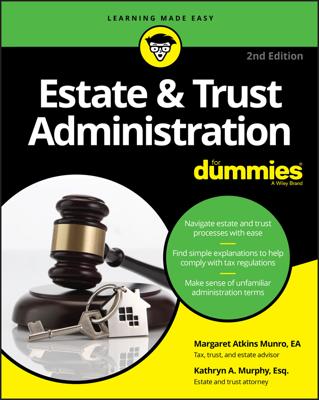After you determine that an estate includes probate assets, you must decide whether you need the formal probate process to administer the estate or if voluntary administration is available to you. Voluntary administration may be available for you in your decedent’s state of domicile or any other state where administration is required. The extent of the estate’s assets usually determines whether formal probate is required or whether voluntary administration is an option.
Voluntary administration for the estate
If your decedent’s probate estate is of limited size, it may qualify for voluntary administration whether or not your decedent left a will. This voluntary administration can save you time and the estate money. For instance, in Massachusetts you may seek voluntary executorship if the decedent dies with a will and leaves only an automobile and personal property worth $15,000 or less.
To use voluntary administration, you need to do the following tasks:
You, the named executor, or administrator if there is no will, file a voluntary statement with the probate court.
Complete a form provided by the court regarding the decedent, his or her assets, heirs at law, devisees and legatees if there is a will, and surviving joint owners of property.
You must certify that you sent the State Division of Medical Assistance copies of the statement and the death certificate by certified mail.
You must also file the original will in the case of executorship and a certified copy of the death certificate.
If someone else doesn’t file a petition for formal probate of the will and all other requirements are met, the court may attest a copy of the statement and/or issue a certificate of appointment to you as executor/administrator. You may then act without further court involvement to pay the expenses and debts of the decedent and distribute any assets.
Note that a voluntary statement, or its equivalent, can’t be filed just to open a safe-deposit box. For that you need to go for temporary executor or special administrator.
These steps are minimal compared with formal probate proceedings. Check with the probate court of the jurisdiction where your decedent was domiciled to see if your decedent’s estate qualifies for voluntary administration.
Formal probate for the estate
If the assets of your decedent’s estate are more than the minimal amount provided for under a special administration statute, you need full, formal probate.
Use formal probate to impose a deadline for the decedent’s creditors to file claims against the estate. Formal probate involves publication of a notice to creditors of the required date for filing claims against the estate. This notice protects the estate and you as the executor/administrator from any later creditor’s claim. With voluntary probate, no such notice is given, and the period for filing claims against the estate may never close.
Your state statutes and probate court rules explain the steps needed to probate the decedent’s will in your state. The probate court registers and other court employees can be helpful. But if they feel you’re trying to use court staff to help you tackle a task that requires a probate attorney, their patience may wear thin. If you’re administering an extensive estate, make sure that you consult an attorney who specializes in estates.

